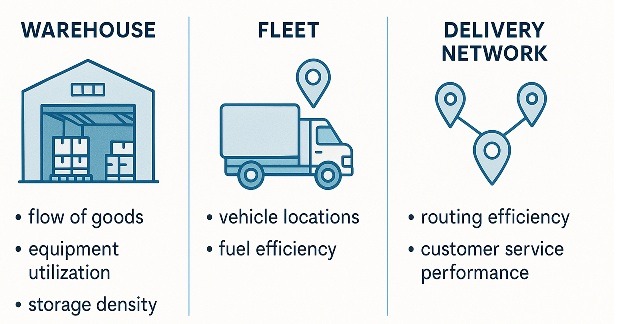
Dynamic Route Optimization: Adapting to Real-Time Condition in Distribution
In today’s fast-moving distribution environment, route plans created at the start of the day can quickly become outdated. Traffic congestion, weather disruptions, unexpected order changes, and last-minute delivery requests can all render inefficient the most carefully designed route. In this article I explore dynamic route optimization, a next-generation approach that adjusts delivery routes in real time, ensuring that every mile counts.
What is Dynamic Route Optimization?
Dynamic route optimization goes beyond traditional static route planning, where paths are set in advance and rarely changed. Instead, it involves continuous monitoring and adjustment of routes using algorithms that process live data. This process recalculates the most efficient path in response to real-time inputs, such as GPS updates, traffic reports, weather forecasts, and even last-minute order changes or cancellations. Unlike static methods, dynamic systems can handle disruptions by rerouting vehicles instantly, minimizing delays and optimizing resource use.
How Dynamic Route Optimization Works?
The core process of DRR relies on a continuous feedback loop driven by powerful algorithms:
Continuous Data Feed: The system constantly ingests real-time data (traffic, weather, GPS location) via API integrations and telematics devices.
Scenario Modeling: Algorithms run rapid calculations to compare the current predicted time of arrival (PTA) with potential PTAs of various alternative routes. This modeling considers distance, travel time, fuel cost, and any time-sensitive constraints (e.g., delivery windows).
Threshold Trigger: A re-optimization is triggered when the potential time saving or cost-reduction of an alternative route exceeds a predefined threshold (e.g., saving more than 5 minutes or 2 miles).
Instant Re-Route: Once the best alternative is identified, the new optimized route segment is immediately communicated to the driver’s device, ensuring they take the most efficient path forward.
Key Benefits of DRR Technology
The implementation of Dynamic Route Optimization yields significant advantages across various sectors, from logistics to personal navigation:

Applications in Distribution and DSD
For Direct Store Delivery (DSD) operations, dynamic re-optimization can transform the day-to-day flow:
- Perishable goods: Rerouting ensures temperature-sensitive items reach stores faster.
- Retail restocking: New store demands can be fulfilled mid-route.
- Promotional deliveries: Urgent point-of-sale campaigns can be integrated on the fly.
Similarly, fleet managers in wholesale and distribution logistics can react instantly to order cancellations, reduce deadhead miles, and rebalance deliveries between vehicles for optimal capacity use.
Enabling Technologies
Dynamic re-optimization is powered by several integrated technologies:
Telematics and IoT sensors: provide real-time vehicle and asset data.
Machine Learning algorithms: predict delays and suggest proactive route changes.
Cloud-based TMS/DSD platforms: enable centralized decision-making and instant updates.
Mobile driver apps: deliver new routes and allow two-way communication with dispatchers.
5G and edge computing: accelerate data transfer, making near-instant optimization possible.
Challenges and Considerations
Despite its advantages, implementation isn’t without hurdles. High initial costs for software and hardware, data privacy concerns, and the need for reliable connectivity can pose issues. Additionally, integrating with existing systems requires careful planning to avoid disruptions. Businesses must also train staff to trust and use AI-driven recommendations effectively.
Conclusion
Dynamic route optimization is transforming how businesses navigate the complexities of modern logistics. By embracing real-time adjustments for traffic, weather, and demand, companies can achieve unprecedented levels of efficiency and adaptability. As tools and technologies evolve, those who invest in this capability will lead the way in sustainable, customer-focused operations.
LaceUp Solutions offers DSD, Route management, and WMS that can support automated warehouse strategies. Contact us for more information on our solutions.
I hope this article have been helpful. I will continue to post information related to management, distribution practices and trends, and the economy in general. Our channel has a lot of relevant information. Check out this video on the subject.


Sorry, the comment form is closed at this time.